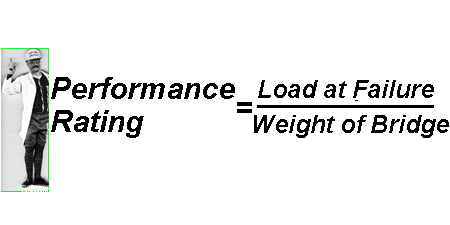Frequently Asked Questions
What is the Popsicle Stick Bridge Competition?
The first answer is that it is not a game of cards. For the first 5 years of the competition, the nice person who looked after room bookings for us thought we were playing cards. That really opened our eyes about our popularity.
This is a contest where the competitors build and test bridges out of a given set of materials, according to a given set of rules. They have some fun and actually learn a little bit about how structures behave. (I warn you that the last bit is highly confidential, and the students must not find out that they’re learning!!) All competitors are on the same level playing field.
There are actually six steps in the process. First, the student conceives of the shape of the structure. There is some analysis followed by design, then the building of the structure. Next comes the fun part; the testing. When the smoke and shrapnel clears, the student usually figures out what went wrong, and vows with a vengeance to return next year. Those that do almost always do better………I believe we call that ‘learning’!
How do you win?
The bridge that carries the greatest number of times its own weight is the winner. This means that the bridge which carries the most load may not necessarily win. We take the load that the bridge fails at and divide it by its own weight to calculate a Performance Rating. The highest PR wins. It means you have to pay very close attention to each bit of weight added to the structure. It has to pay dividends. If you want a simpler explanation:

What are the rules?
Very simply; the bridge must be built only from the materials we supply in the kit, it must fit within given dimensions, and it must not weigh any more than 250 grams. For complete rules read the Rules and Prizes section.
Are prizes awarded?
Yes! College Prizes and Secondary School Prizes.
How is the bridge tested?
The bridge is placed in a testing jig. A 12 mm wide bar extends across the bridge at midspan. The testing head pushes down until the bridge fails. A load cell on the testing head collects real time data and transfers it to a customized data collection program. The results are instantly turned into performance rating, rank, etc. By the way, failure doesn’t necessarily mean breaking into several pieces. If the bridge goes unstable or should it deflect more than 35 mm, then the bridge has ‘failed’.
Do toy cars or trains have to be able to cross the bridge?
No. There is no requirement for a deck on the bridge. In fact this will only add weight to the bridge and bring the performance rating down.
Who can enter?
We have two main competitions every year; a Secondary School and a College competition. Basically, anyone who is a full time student in Secondary School or College, and carrying a full course load can enter. Check the rules or give us a call if you have any questions.
What is the biggest load ever carried?
The best ever was in 1997 when Mark Belanger’s bridge carried 2503 lbs. or 5300 times its own weight. Remember it’s the number of times its own weight, or Performance Rating, that decides the winner. Mark was a 3rd year Civil Engineering Technology student at the time.
What happens if I use unauthorized materials?
Super Mario trained all his team to know! Whether he is there or not, we will discover it and expose you and your bridge! We take great pleasure in destroying cheaters!!
What is the airspeed velocity of an unladen swallow?
What do you mean, an african or a european swallow?
How many members can be on a team?
Maximum 2 per team in the college event. Maximum 3 per team in the high school event.
Is there an entry fee?
For the secondary schools there is no entry fee, as we want to get these folks turned on to technology. For college entrants there is a fee of $10.00. The fee gets you all the sticks and glue you need to create your structure. And the best part is that the majority of the monies collected are donated to the CHML/Y108 Christmas Tree of Hope. Other portions of the revenue are put up as prize money in both competitions.
How do you register?
Traditionally, you come and see us in room A032 or we come and see you. You fill out the form and we give you the sticks and glue. Otherwise contact Matthew Shelley at matt.shelley@mohawkcollege.ca or Gim Ledesma at gimuel.ledesma@mohawkcollege.ca
